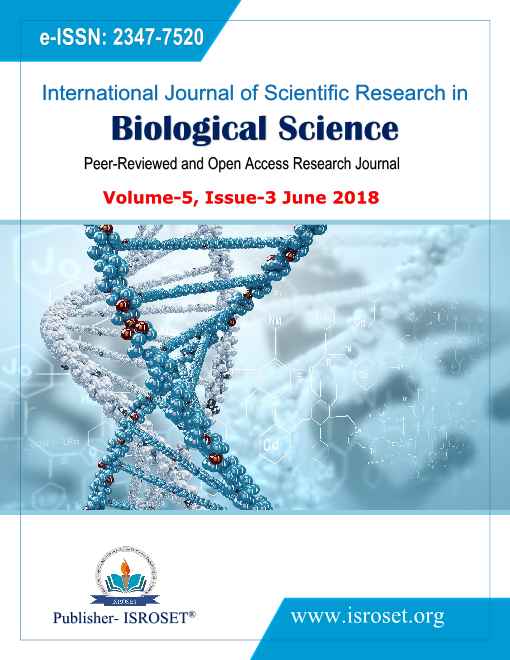Physico-Chemical Characteristics of a Fresh Water Pond of Ghugus, District Chandrapur, Maharashtra (India)
Keywords:
Physico-chemicals, Malgujari Talav, pollution, pH, TDS, DO, BODAbstract
Water is the most necessary component for the living beings. Life on the earth is never possible without water. Water is one of the most vital elements for the human environments. It is being used for many purposes e.g. Industrial water supply, drinking, irrigation, propagation of fish and other aquatic systems and generation of hydro-power plants. Water is the main source of energy and governs the evolution on the earth. 71.9 % of earth surface is covered with water (CIA, 2008), out of which, 96.5% of the world’s water is sea water which is salty that is not to be directly useful for irrigation, drinking, domestic and industrial purposes.1.7% is in groundwater and 1.7% in glaciers and the ice caps. Less than 1% water is present in ponds, lakes, rivers, dams, etc., which is used by human beings for drinking, industrial , domestic and agricultural purposes. According to an estimate about 70% of all the available water in our country is polluted due to the discharge of effluents from the industries, domestic waste, land and agricultural drainage (Shrivastava and Kanungo, 2013). In the present study an attempt has been made on physico-chemical characteristics of a pond, located in Ghugus Town in Chandrapur district of Maharashtra. The study was carried out for a period of twelve months i.e. November 2014 to October 2015. Monthly details have been collected and were represented seasonally along with standard deviation. Different parameters were taken in the study were Humidity, Atmospheric and water temperature, pH, Electrical Conductivity, Total Dissolved Solids, Dissolved oxygen, Biochemical Oxygen Demand, Total alkalinity, Bicarbonate Alkalinity, Total Hardness, Calcium Hardness, Chloride, Nitrate-Nitrogen and Phosphate. The results of the present study indicated that the water of the pond lies just below the level of eutrophication.
References
J. A. Adakole, “The effects of domestic, agricultural and industrial effluents on the water quality and biota of Bindare stream, Zaria-Nigeria”, , Department Of Biological Sciences, Ahmadu Bello University, Zaria, Nigeria, pp. 256, 2000. Phd Thesis
A. D. Adoni, “Studies on microbiology of Sagar lake”, , Sagar University,Sagar,India, pp. 216 1975. Ph.D. Thesis
A. D. Adoni, G. Joshi, K. Gosh, S. K. Chaurasia, A. K. Vashya, Manoj Yadav and H. G. Verma, Work book on limnology”, Pratibha Publishers C-10, Gour Nagar, Sagar-470003, India. 1985.
A. A. Ahluwalia, “Limnological Study of wetlands under Sardar Sarovar command area”,Gujarat University, Ahmedabad, 1999.Doctoral Dissertation
D. M. Anderson, A. D. Cembella. and G. M. Hallegraeff, “Physiological Ecology of Harmful algal blooms”, (Berlin: Springer- Verlag,), 1st Edn, pp. 647-648,1998
K. K. Ansari, and s. Prakash , “Limnolocial studies on Tulsidas Tal of Tarai region of Balrampur in relation to fisheries”, Poll. Res. 19(4), pp. 651-655, 2000
APHA, “Standard Methods for the Examination of water and wastewater”, American PublicHealth Association, Washington D. C., pp. 1000, 1998
G. S. Carter, “Tropical climates and Biology, Nature (Lond)” Vol. 187, p.843,1960
M. Chaurasia, and G.C. Pandey, “Study of physic- Chemical characteristic of some water pond of Ayodhya-Faizabad” Indian J. of Environmental protection, Vol. 27, Issue. 11, pp.1019-1023, 2007.
S. K. Chourasia, and A. D. Adoni, “ Zooplankton dynamics in a shallow Eutrophic lake”.Proc. Nat. Symp.Pure Appl. Limnology Bot. Soc. Sagar, Vol.32, pp. 30- 39, 1985
A. H. Chowdhury, and A. A.Mamun, “Physio-chemical conditions and plankton population of two Fish ponds in Khulna” ,Univ. j.zool. Rajshahi Univ. Vol. 25, pp. 41-44. 2006.
O. K. Dutta, and S. K. Bhagawati, (); “Limnology of Ox-bow Lake of Assam”,NSL, pp. 3-7, 2007.
R. Bahekar , Y.There, “Seasonal variation in physico-chemical characteristics of Koradi Lake,District Nagpur”, India. Indian Streams Research Journal, Vol.3, Issue. 2, pp.1-5, 2013
S. M. Banerjea, “Water quality and soil condition of fish ponds in states of India in relation to fish Production”, Indian journal of Fisheries, Vol. 14, Issue.2, pp. 115-144, 1967
P.Choudhary, N. K.Dhakad, R. Jain, “Studies on the Physico-Chemical Parameters of Bilawali Tank,Indore (M.P.) India”. IOSR Journal of Environmental Science, Toxicology and Food Technology (IOSRJESTFT), Vol. 8, Issue. 1, pp. 37-40, 2014.
S. K. Shrivastava,V. K.Kanungo, “Physico- Chemical Analysis of Pond Water of Surguja District,Chhattishgarh, India”. International Journal of Herbal Medicine, Vol.1, Issue.4, pp. 35-43, 2013.
S. Umavathi,K. Longakumar, P. Subhashini.“Studies on the nutrient content of Sulur pond in Coimbator,Tamil Nadu”, Journal of Ecology and Environmental Conservation, Vol.13,Issue.5, pp. 501-504, 2007
B. K. Dwivedi and G. C.Pandey, Physicochemical factors and algal diversity of two ponds in Faizabad, India, Vol. 21, Issue 3, pp. 361-370, 2002
P. N. Goel, A. Y. Khatavkar, A. Y. Kulkarni and Trivedy R. K. (1986); “Limnological studies of a few freshwater bodies in southwestern Maharasthra with special reference to their chemistry and pollution”, Vol, 5, No.2,, pp. 79-84, 1986
S. Khurshid, Zaheeruddin and A. Basheer,); “Pollution assessment and water quality status in parts of Cochin”, I.J.E.P,Vol. 18, No.4, pp. 246- 249. 1997
Downloads
Published
How to Cite
Issue
Section
License

This work is licensed under a Creative Commons Attribution 4.0 International License.
Authors contributing to this journal agree to publish their articles under the Creative Commons Attribution 4.0 International License, allowing third parties to share their work (copy, distribute, transmit) and to adapt it, under the condition that the authors are given credit and that in the event of reuse or distribution, the terms of this license are made clear.







